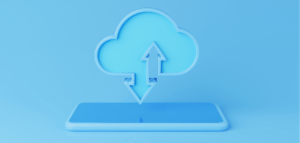The cloud continues to gain in popularity. This is the conclusion that can be drawn from reading Flexera’s report, which opens with the information that 9 out of 10 companies anticipate using cloud computing. The pandemic has shown policymakers that the flexibility and innovation of the cloud help build businesses more nimbly and respond to rapidly changing market conditions.

The war in Ukraine has finally appealed to the unconvinced
The government of our neighbor moved key resources to the cloud just a week before the war. Thanks to this, they were able to maintain business continuity in the early days of the conflict, as it was the data centers in government buildings that were targeted by a missile and hacking attacks. At the same time, the data was already secured on distributed servers in other European countries.
– Although there are some benefits to centralizing government operations in peacetime, the last few months in Ukraine show the defense needs which are due to the war, Microsoft writes in its report.
Ukraine managed to change the law on storing sensitive information at the last minute. Regulations today are the main challenge in terms of migrating data and processes to the cloud. The main one, but not the only one. According to IDC, 70 percent of applications today are outside the public cloud, and some are even leaving the cloud due to unsatisfactory performance, lack of transparency of online services, cost of service, and, of course, regulations. Many businesses still limit their use of the cloud to just email or an office suite.
Some of the applications cannot be moved to the cloud
How to deal with this challenge? Since companies will not “move to the cloud,” you can “bring the cloud to them,” i.e., create an experience straight from cloud applications, but in a local data center. Amazon or Microsoft already allows services to be moved from AWS or Azure to the on-premises world. Vendors are integrating hardware and software in the form of products such as AWS Outposts, Azure Stack Hub, or IBM Cloud Satellite, taking advantage of the fact that it does not matter to the user whether the application runs in the cloud or on a server floor below. The most important are responsiveness, reliability, and security.
How exactly do these products work? Let’s say a large corporation maintains its own data center in Warsaw, but with the latest services, it can use cloud technologies, such as container or database technologies, in it. The key point, however, is that the data does not leave the local network, so the company does not have to share its most valuable resource with anyone. However, a machine learning engineer can train his programs using information from various databases managed by corporations and connected by an encrypted link.
Remarkably, as traditional computing power providers are conquering local data centers, infrastructure providers are developing their cloud-based solutions. Both worlds interpenetrate thanks to products such as HPE GreenLake, Dell Apex, Cisco Plus, and NetApp Keystone. They all contain several facilities
when managing servers. This is, for example, usage monitoring linked to automation that allows you to quickly respond to new service requests or better cost control based on pay-per-use, known from the cloud world.
The last one is the most popular initiative that companies will be focusing on in the coming years.

Costs under control
The Flaxer report shows that migration budgets were exceeded by 13 percent in 2021. Therefore, in the future, companies will pay more attention to optimizing costs and using services that help reduce bills.
The Couchbase survey, on the other hand, cites inadequate security, inflexible pricing, or vendor lock-in among the top factors driving up fees, causing companies to rotate through a limited list of supported software or face difficulties in maintaining the solution. The constraints for 61 percent of companies surveyed by Couchbase have led to a reduction in digital transformation projects.
Trends in data processing development indicate that a hybrid model works best. Under it, some applications run in the cloud, others in a local server room, and some analyze data at the edge of the network. Each of these models is dedicated to a different type of data and application. Some of the information must be processed directly on the device that recorded it. These include an autonomous car, or a drone patrolling forests in search of fire. Particularly sensitive information requiring the highest performance will be used locally, but already flexible applications with global access will go to the cloud. Companies should consider all these models when planning their digital transformation and build solutions that best address the challenges of a rapidly changing world.
If you are looking for cloud solution specialists, contact us!

